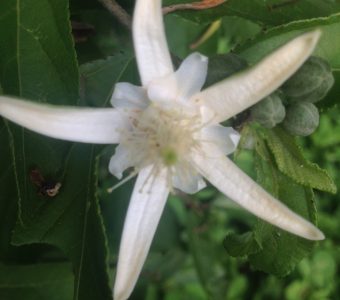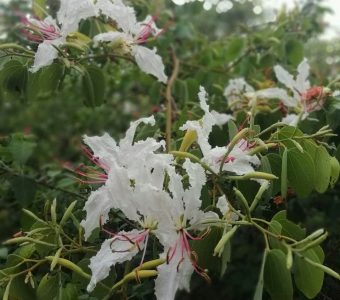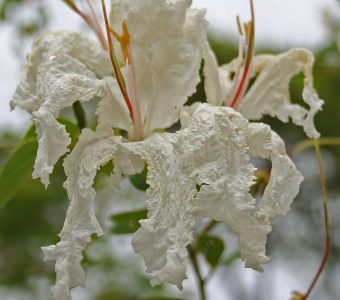


Botanical Name: Bauhinia petersiana Bolle
Synonym: Bauhinia macrantha Oliv.
Common Name: White Bauhinia
Plant Family: Caesalpinaceae
Origin: Africa
References: Coates Palgrave p.335, Storrs 1 p.75-76, Venter p.248. S.A. No. 208,3, Zimb No. 263
Description: B. petersiana is an evergreen shrub or small tree. It is easily identified by the two lobed camel foot leaves and white flowers.
Features of Particular Interest: Large showy flowers crinkly white petals flowering between September and February. Flowers look like paper hankies. Pods are large fat smooth splitting in July to September.
Height and Spread: 3 – 4 metres as shrub or 7 m as a tree, spread 3-5m.
Periods of Interest:
Leaf: All year round.
Flowering: October to February.
Fruiting/pod: July to September.
Cultivation
Soil and Moisture: B. petersiana prefers sandy soils.
Aspect: No special aspect but likes open sun.
Hardiness: Can withstand long periods of drought. It can take cold but not frost when young.
Maintenance and Pruning: Keep pruned or becomes untidy.
Propagation: Propagated from seeds. Soak seeds in hot water and leave overnight. Growth is up to 800mm a year.
Problems and Drawbacks: B. petersiana is rather untidy, and its exotic relations are probably more suitable for gardens.
Use and Associated Planting: Domestic stock and game eat the leaves and pods, louries/turacos and Meyer’s Parrots like the flower buds and flowers. Seeds are highly nutritious roasted, with a nutty flavor. White Bauhinia can be used effectively as a screen plant or in a shrubbery in dry areas, also a specimen plant, in a flowerbed. Useful in small garden provided growth kept compact. Display of white flowers best in contrast with B. galpinii or other colorful flowering plant. Non-aggressive root system.
